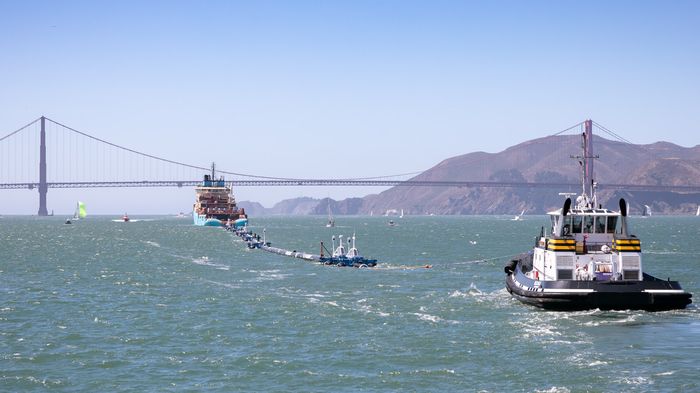
The World’s First Ocean Cleanup System Launched from San Francisco
Back to pressSan Francisco (USA) and Rotterdam (the Netherlands), September 8, 2018 – The Ocean Cleanup, the Dutch non-profit organization developing advanced technologies to rid the oceans of plastic, today launched the world’s first ocean cleanup system from the San Francisco Bay. The cleanup system (“System 001”) is heading to a location 240 nautical miles offshore for a two-week trial before continuing its journey toward the Great Pacific Garbage Patch, 1,200 nautical miles offshore, to start the cleanup. System 001 is being towed from the San Francisco Bay by the vessel Maersk Launcher, which has been made available to the project by A.P. Moller-Maersk and DeepGreen, its current charter holder.
Hundreds of scale-model tests, a series of prototypes, research expeditions and multiple iterations have led to The Ocean Cleanup having sufficient confidence in its technology to launch its first full-scale cleanup system. System 001 consists of a 600-meter-long (2000 ft) U-shaped floating barrier with a three-meter (10 ft) skirt attached below. The system is designed to be propelled by wind and waves, allowing it to passively catch and concentrate plastic debris in front of it. Due to its shape, the debris will be funnelled to the center of the system. Moving slightly faster than the plastic, the system will act like a giant Pac-Man, skimming the surface of the ocean.
The system will be deployed in the Great Pacific Garbage Patch, the world’s largest accumulation zone of ocean plastics. Situated halfway between Hawaii and California, the patch contains 1.8 trillion pieces of plastic, and covers an area twice the size of Texas.
The Ocean Cleanup anticipates that the first plastic will be collected and returned to land within 6 months after deployment. This will mark the first time that free floating plastic will have been successfully collected at sea. After returning the plastic to land, The Ocean Cleanup plans to recycle the material into products and use the proceeds to help fund the cleanup operations.
While the main objective of System 001 is to prove the technology and start the cleanup, a secondary goal is to collect performance data to improve the design for future deployments. Hence, the system is equipped with solar-powered and satellite-connected sensors, cameras and navigation lights to communicate the position of System 001 to passing marine traffic, and enable extensive monitoring of the system and the environment. After delivery of the system to the Great Pacific Garbage Patch, the Maersk Launcher will remain active as an observation platform for several weeks.
“Maersk contributes to the protection of the ocean environment through our sustainable activities in both ocean and land-based activities. As a responsible maritime operator, we are committed to ensuring that the oceans remain a healthy environment for generations to come. We are therefore very pleased to contribute with services and equipment to The Ocean Cleanup.” says Claus V. Hemmingsen, Vice CEO of A.P. Moller – Maersk and CEO of the Energy division.
Boyan Slat, Founder and CEO of The Ocean Cleanup, stated: “I am incredibly grateful for the tremendous amount of support we have received over the past few years from people around the world, that has allowed us to develop, test, and launch a system with the potential to begin to mitigate this ecological disaster. This makes me confident that, if we manage to make the technology work, the cleanup will happen.”
Boyan Slat added, “Today’s launch is an important milestone, but the real celebration will come once the first plastic returns to shore. For 60 years, mankind has been putting plastic into the oceans; from that day onwards, we’re taking it back out again.”
Once successful, and if the funding is available, The Ocean Cleanup aims to scale up to a fleet of approximately 60 systems focused on the Great Pacific Garbage Patch over the next two years. The Ocean Cleanup projects that the full fleet can remove half of the plastic in the Great Pacific Garbage Patch within five years’ time. This is in line with The Ocean Cleanup’s ultimate goal: reducing the amount of plastic in the world’s oceans by at least 90% by 2040.
END
Note for the editors, not for publication.
Press contact:
CFF Communications, Amsterdam
Jan van Ewijk / Claire Verhagen
Press@theoceancleanup.com
T: +31 20 575 4010
Photos and video footage can be downloaded here. The press kit for the launch is available here.
About The Ocean Cleanup
The Ocean Cleanup develops advanced technologies to rid the world’s oceans of plastic.
Founded in 2013 by Boyan Slat (24), The Ocean Cleanup now employs approximately 80 engineers and researchers. The foundation is headquartered in Rotterdam, the Netherlands.
Instead of going after plastic debris with vessels and nets – which would take many thousands of years and billions of dollars to complete – The Ocean Cleanup plans to deploy a fleet of extremely long floating barriers that act like an artificial coastline, enabling the winds and waves to passively catch and concentrate the plastic. Once fully operational, the full fleet of passive collection systems is expected to remove 50% of the Great Pacific Garbage Patch in 5 years’ time.
After years of conducting reconnaissance expeditions, scale model tests and the deployment of prototypes on the North Sea, the world’s first full-scale cleanup system is soon to be deployed in the Great Pacific Garbage Patch. It is expected that the first shipment of debris collected by this system will be returned to land for recycling within 6 months after deployment. The Ocean Cleanup is working to design processes to convert recovered ocean plastic into valuable raw materials and durable products.